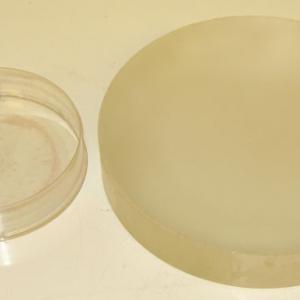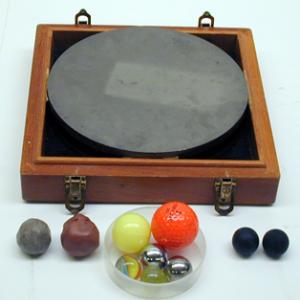College of Liberal Arts & Sciences
1R40.10 - Coefficient of Restitution
The curve of the telescope mirror blank will keep the ball from bouncing off the blank if the ball bounces somewhere near the center on the first bounce. Use ball bearing no larger than 1/4 inch diameter or you risk damaging the glass mirror blank. Coefficients as high as 90 percent or better may be obtained with this system.
Bounce the various balls on the steel plate and observe the coefficient of restitution. The ball with the best coefficient should be the steel ball.
The happy - sad ball set has one ball that is much like a super ball and one ball that will absorb all of the energy and therefore will not bounce. The bouncing ball is made from polyneoprene and the non-bouncing ball is made from polynorbornene.
- Rod Cross, "Energy Losses in a Bouncing Ball", TPT, Vol. 61, #6, Sept. 2023, p. 444.
- David Marasco, "Teaching an Old Ball New Tricks: Another Look at Energetic, Motion Detectors, and a Bouncing Rubber Ball", TPT, Vol. 58, #1, Jan. 2020, p. 62.
- Kelley D. Sullivan, "What’s in a Name: Why Do We Call a Bouncy Ball Bouncy?", TPT, Vol. 57, #4, Apr. 2019, p. 229.
- Jim Rohr, Veronica Lopez, and Tyler Rohr, "Reflections on a Bouncing Ball", TPT, Vol. 52, #9, Dec. 2014, p. 534.
- Jing Wang and Marco Ciocca, "Watching and Listening to the Coefficient of Restitution", TPT, Vol. 50, #8, Nov. 2012, p. 503.
- Rod Cross, "Enhancing the Bounce of a Ball", TPT, Vol. 48, #7, Oct. 2010, p. 450.
- Eric Gettrust, "The Energetics of Bouncing (Revisited): A Quantitative Demonstration of Energy Conservation During Bouncing", TPT, Vol. 44, #7, Oct. 2006, p. 428.
- K. C. Maynes, M. G. Compton, and Blane Baker, "Coefficient of Restitution Measurements for Sport Balls: An Investigative Approach", TPT, Vol. 43, #6, Sept. 2005, p. 352.
- Warren A. Turner and Glenn W. Ellis, "The Energetics of a Bouncing Ball", TPT, Vol. 37, #8, Nov. 1999, p. 496.
- Russell Akridge, "Period and Amplitude", TPT, Vol. 36, #8, Nov. 1998, p. 507.
- R. Jones, "Follow the Bouncing Ball", TPT, Vol. 31, #5, May 1993, p. 313.
- Herbert R. Bailey, "Experiments on Free Fall and Rebound", TPT, Vol. 28, #2, Feb. 1990, p. 100.
- Judith Bransky, "A Measurement Using the Piezoelectric Effect", TPT, Vol. 27, #8, Nov. 1989, p. 637.
- Donna A. Berry, "Television Experiments", TPT, Vol. 26, #8, Nov. 1988, p. 541.
- R. D. Edge, "String & Sticky Tape Experiments: Coefficient of Restitution", TPT, Vol. 26, #8, Nov. 1988, p. 540.
- George T. Johnston, "The Scientific Method and Cooled Superball", TPT, Vol. 16, #3, Mar. 1978, p. 172.
- Harry H. Kemp, "Teacher Pets: Elasticity Shown with Mirror Blank and Marble", TPT, Vol. 15, #7, Oct. 1977, p. 420.
- Paul J. Hatchell, "Investigating t(infinity) for Bouncing Balls", AJP, Vol. 89, #2, Feb. 2021, p. 147.
- C. E. Aguiar and F. Laudares, "Listening to the Restitution and the Gravitational Acceleration of a Bouncing Ball", AJP, Vol. 71, #5, May 2003, p. 499.
- I. Stensgaard and E. Laegsgaard, "Listening to the Coefficient of Restitution-Revisted", AJP, Vol. 69, #3, Mar. 2001, p. 301.
- D. Gugan, "Inelastic Collision and the Hertz Theory of Impact", AJP, Vol. 68, #10, Oct. 2000, p. 920.
- G. Guercio and V. Zanetti, "Determination of Gravitational Acceleration Using a Rubber Ball", AJP, Vol. 55, #1, Jan. 1987, p. 59.
- K. Sundaralingam, "Comment on 'Listening to the Coefficient of Restitution'", AJP, Vol. 46, #9, Sept. 1978, p. 951.
- Philip A. Maurone and Francis J. Wunderlich, "Bouncing Ball Experiment", AJP, Vol. 46, #4, Apr. 1978, p. 413.
- Alan D. Bernstein, "Listening to the Coefficient of Restitution", AJP, Vol. 45, #1, Jan. 1977, p. 41.
- S. K. Foong, D. Kiang, P. Lee, R. H. March, and B. E. Paton, "How Long Does It Take a Bouncing Ball to Bounce an Infinite Number of Times?", Physics Education, Vol. 39, #1, Jan. 2004, p. 40.
- G. D. Freier and F. J. Anderson, "Mw-3", A Demonstration Handbook for Physics.
- Richard Manliffe Sutton, "M-69", Demonstration Experiments in Physics.
- Bill Franklin, "Coefficient of Restitution Apparatus", Teaching About Impulse and Momentum, p. 4.18.
- George M. Hopkins', "Elasticity", Experimental Science, Vol. 2, p. 107.
- Ron Hipschman, "Bouncing Ball", Exploratorium Cookbook III, p. 199-1 - 199-4.
- Robert Ehrlich, "Coefficient of Restitution", Why Toast Lands Jelly-Side Down, p. 93 - 96.
Disclaimer: These demonstrations are provided only for illustrative use by persons affiliated with The University of Iowa and only under the direction of a trained instructor or physicist. The University of Iowa is not responsible for demonstrations performed by those using their own equipment or who choose to use this reference material for their own purpose. The demonstrations included here are within the public domain and can be found in materials contained in libraries, bookstores, and through electronic sources. Performing all or any portion of any of these demonstrations, with or without revisions not depicted here entails inherent risks. These risks include, without limitation, bodily injury (and possibly death), including risks to health that may be temporary or permanent and that may exacerbate a pre-existing medical condition; and property loss or damage. Anyone performing any part of these demonstrations, even with revisions, knowingly and voluntarily assumes all risks associated with them.

